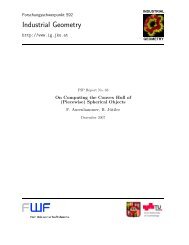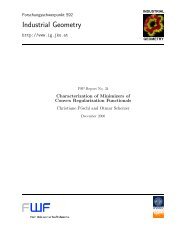Solving constrained ill-posed problems using Ginzburg-Landau ...
Solving constrained ill-posed problems using Ginzburg-Landau ...
Solving constrained ill-posed problems using Ginzburg-Landau ...
You also want an ePaper? Increase the reach of your titles
YUMPU automatically turns print PDFs into web optimized ePapers that Google loves.
4 F. FRÜHAUF, H. GROSSAUER AND O. SCHERZER<br />
for solutions of (2.5) with z ɛ (·, 0) = 1 + χ σ E . Here χσ E denotes a slightly<br />
smoothed version of χ E with sgn(χ σ E ) = sgn(χ E), and E t denotes the set<br />
which originates from E if its boundary ∂E evolves under mean curvature<br />
motion up to time T . In this sense (2.5) approximates mean curvature motion<br />
as ɛ tends to zero. Further details can be found in [1].<br />
To solve (1.1) under constraint C2 we observe the following methods:<br />
1. Tikhonov: To minimize the functional (1.7) we choose again the H 1 -Tikhonov<br />
regularization functional R(z) = 1 2 ‖z − z 0‖ 2 H 1 (Ω). Here we do not introduce<br />
the constraint z ∈ [a, b].<br />
2. Complex GL: Finally we consider the complex GL functional T from (1.9).<br />
In the example in 4.2 we have the a-priori knowledge that z(x) ∈ [1, 2] for<br />
x ∈ Ω. Therefore we set<br />
(2.8)<br />
W (s) = 1 4<br />
(<br />
|s − 3 2 |2 − 1 ) 2<br />
4<br />
which attains its minimum on the complex sphere with center 3 2<br />
1<br />
2<br />
. Thus we force z to have values in [1, 2].<br />
We find the variational derivative of T<br />
T ′ (v) = −λ∆v + 1 (<br />
|v − 3 λ 2 |2 − 1 ) (<br />
v − 3 )<br />
(2.9)<br />
.<br />
4 2<br />
and radius<br />
(<br />
Solutions of −λ∆v + 1 λ |v| 2 − 1 ) v = 0 have been investigated in detail in<br />
[2]. Equation (2.9) is attained by an appropriate coordinate transform and<br />
therefore its solutions have similar properties.<br />
We can guarantee the existence of a minimizer for F ɛ,α .<br />
Theorem 2.1. The functional F ɛ,α from (2.2) attains a minimizer φ ɛ,α , if R<br />
is weak lower semi continuous, if there exist c > 0 and b ∈ IR such that R(φ) ><br />
c‖φ‖ 2 H 1 (Ω) + b for all φ ∈ H1 (Ω), and there exists at least one ˜φ ∈ H 1 (Ω) such that<br />
F ɛ,α ( ˜φ) is finite.<br />
The proof for the Tikhonov regularization can be found in [8]. To fulf<strong>ill</strong> the<br />
required conditions of the regularization functional we need appropriate boundary<br />
conditions for the GL regularizers, for example see section 3.2. Then the theorem is<br />
also applicable for the functionals (1.5), (1.7) and (1.8).<br />
Note that the assumptions of the theorem do not necessarily imply that lim P (φ ɛ,α) ∈<br />
ɛ→0+<br />
P. In [8] this condition was enforced by introducing the BV-seminorm |P ɛ (φ)| BV as<br />
additional penalizing term.<br />
3. Numerics. To receive a minimizer of the functionals we calculate the formal<br />
optimality conditions. In section 2 we derived the variational derivatives of the<br />
regularizing terms. Now we consider the derivative of the data term.<br />
3.1. The variational derivative of the data term. In our numerical examples<br />
we consider an operator F which corresponds to the inverse conductivity problem.<br />
We can formulate the <strong>problems</strong> as follows:<br />
C1: We are interested in determining inclusions of constant conductivity in a<br />
surrounding medium of a different constant conductivity.<br />
C2: We want to reconstruct conductivities which are assumed to take on values<br />
in a certain interval.







